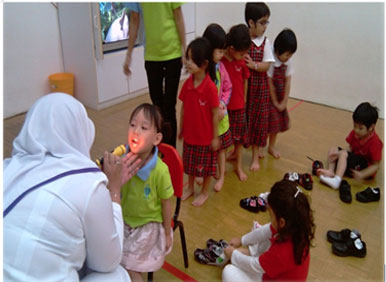|
Communication Across Borders: Hand, Foot, and Mouth Disease (HFMD)
Hand, Foot, & Mouth Disease (HFMD) is prevalent in many Asian countries and commonly occurs among children aged less than five years. Of the Association of Southeast Asian Nations (ASEAN) and Plus Three Countries, large increases in cases have been identified in China, Japan, Malaysia, Republic of Korea, Singapore, Thailand and Vietnam over the past few decades. The etiologies include several enteroviruses (subgenotype B5, C4, etc.). Mild disease is most common and caused by coxsackievirus A16. The severe form of HFMD caused by Enterovirus 71 (EV 71) can lead to neurological, cardiovascular, and respiratory problems as well as death. The disease is transmitted through exposure to the upper respiratory tract secretion, saliva, feces of patients or by asymptomatic cases. Outbreaks commonly occur in day care centers and schools. Currently, there is no vaccine or anti-viral treatment for HFMD.
As of 22 July 2012, the accumulated number of confirmed HFMD cases increased to 16,860 in Thailand. Three deaths have been confirmed to have been caused by EV 71. In response to the HFMD situation, Thailand's MoPH has informed the public and medical specialists that steroids should not be taken if HFMD is suspected. The MoPH has also set up a panel of experts that can be contacted by both public and private practitioners located nationwide for medical advice. Thailand's Field Epidemiology Training Program (FETP) is currently conducting an investigation.
In light of Thailand's HFMD situation, ASEAN+3 FETN hosted a regional HFMD Situation and Testing of "Real Time" Information Sharing Video Conference, Monday, 6 August 2012, 13.30-15.00. Thailand shared information for cases both mild and fatal, laboratory surveillance, genotype identified in Thailand, and Thai FETP's role in outbreak investigations. Cambodia, Philippines, Singapore and Vietnam also shared their current HFMD situation. Meeting participants included Cambodia's Dr. Bun Sreng and Dr. Sok Touch; China's Dr. Huilai Ma; Indonesia's Dr. I Nyoman Kandun; Singapore's Dr. Pengiran Hishamuddin, Mr. Mohammad Fauzy Bin Mos, and Mr. Soon Kok Lim; Thailand's Dr. Kumnuan Ungchusak, Dr. Rungreung Kitphati, & Dr. Rome Buathong; Vietnam's Dr. Hoang Quoc Cuong; WHO Indonesia's Dr. Khanchit Limpakarnjanarat; WHO SEARO's Dr. Vason Pinyowiwat; WHO WPRO's Dr. Tamano Matsui, Dr. Wu Huanyu, Mr. Taku Wakui, and Mr. Noel Orosco; and ASEAN Secretariat's Ms. Jintana Swirawongsa. Technical difficulties prohibited participation for representatives based in Japan, Lao PDR, Myanmar, and the Philippines.
Below you will find relevant information, publications and progress of HFMD events in the ASEAN Plus Three Countries.
|

Brunei Darussalam's field epidemiology activities to prevent and control HFMD in 2011 included active case finding in kindergarten classrooms and child care centers
|
HFMD Information
Information Sheet (WHO WPRO)
Information & Topics (US CDC) HFMD: Available Publications
Brunei Darussalam: Enterovirus 71 Outbreak, Brunei
China: Glucocorticoid and Pyrazolone Treatment of Acute Fever is a Risk Factor for Critical and Life-Threatening Human Enterovirus 71 Infection During
an Outbreak in China, 2008
China: Risk Factors for Hand, Foot, and Mouth Disease and Herpangina and the Preventive Effect of Hand-washing
Japan: Detection and Quantification of Enterovirus 71 Genome from Cerebrospinal Fluid of an Encephalitis Patient by PCR Applications
Japan: Hand, Foot, and Mouth Disease Caused by Coxsackievirus A6, Japan, 2011
Japan: Risk factors for severe hand foot and mouth disease
Singapore: The changing seroepidemiology of Enterovirus 71 infection among children and adolescents in Singapore
Singapore & REDI Centre: Forum on Hand Foot and Mouth Disease (HFMD) in Asia-Pacific Region Epidemiological, Laboratory, Clinical, and Public Health Aspects
Thailand: Cluster of Fatal Cardiopulmonary Failure among Children Caused by an Emerging Strain of Enterovirus 71, Nakhorn Ratchasima Province, Thailand, 2006
World Health Organization: A Guide to Clinical Management and Public Health Response for Hand, Foot and Mouth Disease (HFMD) HFMD: Situation Update Among ASEAN Plus Three Countries Brunei Darussalam
Press Release (3 March 2012)
HFMD Surveillance Trend (2000-2010) Cambodia
Outbreak News China
Monthly Infectious Diseases Bulletin (June 2012) Indonesia
Press Release (11 February 2012)
Press Release Japan
Press Release (March 2012) Lao PDR
Press Release (24 July 2012) Malaysia
HFMD Updates Philippines
Press Release (31 July 2012) Republic of Korea
Press Release (12 July 2012) Singapore
Weekly Infectious Diseases Bulletin
HFMD Surveillance
| Case Surveillance: HFMD is a legally notifiable disease under the Infectious Diseases Act (IDA) in Singapore. Medical practitioners are to notify all clinical cases of HFMD to MOH within 24 hours of diagnosis. Related document: Notification of Infectious Disease - MD 131 Form | | Cluster Notification in Educational Institutions: Childcare centers, kindergartens and schools are to report HFMD clusters to MOH using the cluster notification form A and B, either via fax or through an online system (CDLens). Related documents: Cluster Notification Form A and Cluster Notification Form B.
| |
Severe Case Surveillance: Pediatric wards in two public hospitals are to inform MOH of any severe case or death related to HFMD. These updates, which indicate the number of HFMD cases hospitalized and/or seen in the Emergency Department, are provided on a weekly basis.
Virological Surveillance: Throat swabs and stool samples are collected from selected cases of HFMD at a pediatric public hospital, a pediatric clinic, as well as sentinel General Practitioner (GP) clinics located all over Singapore. Samples are either tested at the pediatric public hospital or sent to the National Public Health Laboratory (NPHL) for testing. GP clinics are required to complete the attached form and send it together with the sample to NPHL. Related document: GP HFMD virus surveillance form. |
HFMD ResponseThailand
Highlights: Prevention & Control Measures
Situation Report (31 July 2012) Vietnam
Press Release (26 July 2012) WHO Western Pacific Region Office
Situation Update (includes information for China, Japan, Republic of Korea, Singapore and Vietnam) For some updates above, translation services may assist:
Google Translate Updated: 15 August 2012 |
|

